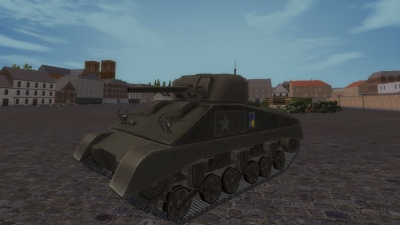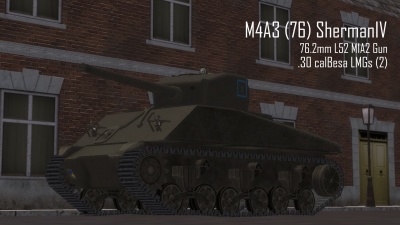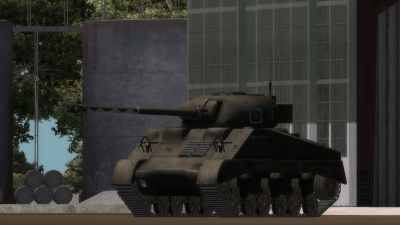M4 Sherman
M4A2 Sherman
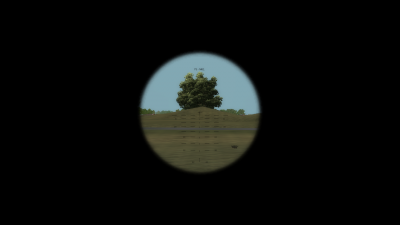
| |
| Main Gun Optics | |
| Specifications | |
| Designation | M55 Telescope |
| Magnification | 3x |
| Field of View | 12° |
History
Originally designed as an exploitation tank, the Medium Tank M4 had excellent reliability, good speed and a 75mm gun with excellent HE rounds. Oddly, US doctrine dictated that only tank destroyers would engage enemy tanks and little attention was paid to its anti-tank capability. Despite this, the M4 - known as the Sherman - became the standard Allied tank by 1944 due to its availability in huge numbers, a result of American manufacturing resources and a lack of any better American product.
When it was first proposed, the Sherman would have dominated the battlefield, but by the time it was deployed, its 75mm gun was outclassed by every other nation’s 75 mm weapons. Various crash programs tried to rectify this, resulting in the conversion of the basic form into numerous subtypes with guns such as the 76 mm M1 Gun, the British 17 Pdr, and even the 105 mm M4 Howitzer.
The M4A2 and its 75mm gun had difficulty dealing with the German Panthers (PzKpfw V) and Tigers (PzKpfw VI), particularly head on. Swarm attacks would help one of the Shermans circle around for a flank or rear shot, but these were tactics of necessity. Another fault of the tank was its size. The Sherman sat high, and its high silhouette would hamper it in ambush.
The Sherman also had a reputation for brewing up. Early Shermans stowed ammunition in dry racks along the walls of the tank. When hit, the ammo would explode and the tank would burn. Its reputation led the Germans to nickname the tank the "Tommy cooker". The British called them "Ronsons", after the cigarette lighter with the slogan "Lights up the first time, every time!". Polish Tankers called them "The Burning Grave".
In an early attempt to rectify the problem, Shermans gained 1-inch-thick armored plates welded to the hull outside the ammunition bins. Later models moved ammunition stowage to the floor and used bags containing a mix of water and ethylene glycol to flood "ready" ammunition below the turret, which kept the risk of fire under control.
Game Play
Despite its shortcomings, the Sherman is a decent medium tank. The high silhouette is not only a disadvantage - it also improves the commander's visibility on the battlefield and it’s easier to find a hull-down position.
Expect to be outranged in gun duels against 75 mm-armed German tanks because your 75 mm is a low-velocity gun. Find a partner and work in teams with a M10 Wolverine and its high-velocity 3 inch gun to essentially recreate the real-time response to the unusual American anti-tank doctrine.
Use cover to keep encounter ranges short where possible. Your HE shell are extremely effective in clearing out buildings and bunkers, but your AP will perform roughly similar to smaller calibers such as the QF 6 Pdr, which fires a smaller 57mm projectile at much higher muzzle velocity. For a medium tank, the Sherman is fast and maneuverable with rapid enough turret rotation to provide an advantage in short-range mobile engagements. This is where you can make up for the 75 mm's poor muzzle velocity - get close where your gun can give you that little bit of extra penetration performance it lacks at longer ranges.
The Sherman has only reasonable armor in most respects - it isn’t a heavy tank. The front turret and mantle are quite thick, and the front glacis has a good slope angle to it, which gives incoming rounds a difficult slope to take purchase on. Longer ranged rounds will bounce or ricochet off. Your hull sides are thin, however, as is the rear hull plate, so try to keep your front facing the enemy. You can increase the effectiveness of the armor by presenting a slight angle off the nose to the enemy - just don't turn enough to expose your weak side as a target.
The driver position in this tank has no view slit, you must either use the periscope (numpad “.” or “Del” key) or unbutton with the “O” key. Unbuttoning will pop your drivers head through the top hull plate into the open air. Crew position 4 has a hull .30 cal LMG with gunsight. Position 4 can unbutton like the driver.
the M4A2 Sherman is available from tier 2.
M4A3 Sherman
History
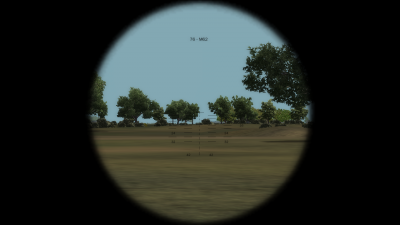
| |
| Main Gun Optics | |
| Specifications | |
| Designation | M51 Telescope |
| Magnification | 3x |
| Field of View | 12° |
|}
Originally designed as an exploitation tank, the Sherman in its original guise had a 75 mm gun with excellent HE rounds. Unfortunately, due to the odd US doctrine that declared that enemy tanks were to be fought only with tank destroyers, little attention was paid to the Sherman’s AT capability, which was not fantastic due to a low velocity AP round.
To counter the huge threat that this presented the Allies with when encountering German tanks with excellent penetration performance and armour, a crash program to refit the Sherman with the far superior 76.2 mmMIA2 AT gun was undertaken almost immediately.
Game Play
With the better gun, the Sherman M4A3(76) is a very good medium tank. The high silhouette does pose a big target; conversely it improves visibility on the battlefield for the commander and it is much easier to find a hull-down position and still fire over the protection of a berm.
Expect that you will be outranged in gun duels against 88 mm armed Tiger tanks should you stumble across one of those monsters. Work in teams and use cover to keep encounter ranges shorter where possible, as your gun will definitely hurt Tigers out to around 1 km, and is very deadly at 500 m.
For a medium tank, it is fast and manoeuvrable with good turret speed to give you a bit more of an advantage in short to medium range engagements.
Get closer when possible to exploit the excellent performance of the M79 ammo, which does not have the advantages of an HE filler (it is solid shot).
It can definitely hurt opposing armour at medium ranges. Tiger tanks will still be hardest to deal with, but even they will have to stand off at long range to resist this up-gunned Sherman. Ask supporting infantry to provide intel reports on the Tigers facing, while you flank, close and then engage.
The Sherman M4A3 is available from tier 3.
Sherman VC Firefly
History

| |
| Main Gun Optics | |
| Specifications | |
| Designation | No.43 x 3 L Mk I |
| Magnification | x3 |
| Field of View | 13° |
The Sherman Firefly was a tank used by the United Kingdom and some Commonwealth and Allied armoured formations in the Second World War. It was based on the US M4 Sherman, but fitted with the powerful 3-inch (76.2 mm) calibre British 17-pounder anti-tank gun as its main weapon. Originally conceived as a stopgap until future British tank designs came into service, the Sherman Firefly became the most common vehicle mounting the 17-pounder in the war. The Firefly was put into production in early 1944, in time to equip Field Marshal Montgomery's 21st Army Group for the Normandy landings. It soon became highly valued, as its gun could almost always penetrate the armour of the Panther and Tiger tanks it faced in Normandy.[2] In recognition of this, German tank and anti-tank gun crews were instructed to attack Fireflies first. Because the Firefly had a visibly longer barrel, crews tried to camouflage it so the tank would look like a normal 75 mm-gun Sherman from a distance.
One example of this increased firepower was displayed by Lt. G. K. Henry's Firefly during the defence of Norrey-en-Bessin on 9 June against an attack by the 3rd Company of the 12th SS Panzer Regiment of the 12th SS Panzer Division. Determined to capture the town in preparation for a larger offensive to drive the British and Canadians back into the sea, Kurt Meyer ordered 12 Panthers of the 3rd Company and infantry to attack Norrey and drive the Canadians out of the town. The attack got under way at 1300 hours, with the Panthers racing towards the town at full speed, stopping only to fire their guns. However, they quickly outran their infantry support, which was forced to ground by Allied artillery fire. Within 1,000 m (1,100 yd) of the town, nine standard Shermans of the Canadian 1st Hussars opened fire into the advancing Panthers' flanks. Lt. Henry's gunner, Trooper A. Chapman, waited until the Panthers "lined up like ducks in a row" and quickly knocked out five Panthers with just six rounds. The attack was repulsed with the loss of seven of the 12 Panthers.
Game Play
The Sherman firefly enters the battlefield in tier 3.
